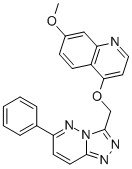All AbMole products are for research use only, cannot be used for human consumption.

AMG 208 is a small molecule inhibitor of c-Met, which inhibits both ligand-dependent and ligand-independent c-Met activation, IC50 = 9.3 nM. The c-MET pathway is dysregulated in most human malignancies, and regulates tumor formation, progression and dissemination, and numerous c-MET pathway inhibitors are currently being evaluated in the clinic. AMG-208 shows the inhibition of HGF-mediated c-Met phosphorylation in PC3 cells with IC50 of 46 nM. Pre-incubation of AMG-208 with human liver microsomes for 30 minutes shows a potent time-dependent inhibition for CYP3A4 metabolic activity with IC50 of 4.1 μM, which is an eightfold decrease relative to the IC50 (32 μM) without preincubation.
| Cell Experiment | |
|---|---|
| Cell lines | PC-3 cells |
| Preparation method | Cell-based autophosphorylation assay of c-Met. IC50 measurements of compound activity on HGF-mediated c-Met autophosphorylation were determined in serum-starved PC-3 (human) cells using a quantitative electrochemiluminescent immunoassay. PC3 cells were plated at a density of 20,000 cells/well in 96 well-plates. 24 hours after plating, cells were starved in media containing 0.1% BSA for 18 to 20 hours. Cells were then treated with a 10-point serial dilution of Compound A for one hour at 37℃ followed by stimulation with optimal concentrations of recombinant human HGF for 10 minutes at 37℃. Cells were washed once with PBS and lysed (1% Triton X-100, 50 mM Tris pH 8.0, 100 mM NaCl, 300 µM Na3OV4 and protease inhibitors). Cell lysates were incubated with a biotin-labeled goat–anti-c-Met antibody for capture followed by a mouse anti-phosphotyrosine antibody 4G10 and a BV-tagTM labeled anti-mouse IgG as the detection antibody. Levels of c-Met phophorylation were then measured on a BioVeris M-Series instrument. The IC50 values are calculated using Xlfit4-parameter equation. |
| Concentrations | IC50=46 nM |
| Incubation time | 10 min |
| Animal Experiment | |
|---|---|
| Animal models | female Balb/c mice |
| Formulation | 2%HPMC, 1%Tween80, in water adjusted to pH 2.2 with HCl |
| Dosages | 3, 10, or 30 mg/kg |
| Administration | oral gavage |
| Molecular Weight | 383.4 |
| Formula | C22H17N5O2 |
| CAS Number | 1002304-34-8 |
| Solubility (25°C) | DMSO 3 mg/mL |
| Storage |
Powder -20°C 3 years ; 4°C 2 years In solvent -80°C 6 months ; -20°C 1 month |
| Related c-Met Products |
|---|
| Zurletrectinib
Zurletrectinib (ICP-723) is a potent tyrosine kinase inhibitor. Zurletrectinib serves as an antineoplastic agent. Zurletrectinib can used for research of TRK-mediated related diseases. |
| ABN401
ABN401 is a highly potent and selective ATP-competitive c-MET inhibitor with an IC50 value of 10 nM. |
| (Z)-Semaxanib
(Z)-Semaxanib is a potent tyrosine kinase inhibitor. |
| MET kinase-IN-2
MET kinase-IN-2 is a potent, selective, orally bioavailable MET kinase inhibitor with an IC50 of 7.4 nM. |
| BMS-817378
BMS-817378 is a potent and selective inhibitor of MET with IC50 of 1.7 nM. |
All AbMole products are for research use only, cannot be used for human consumption or veterinary use. We do not provide products or services to individuals. Please comply with the intended use and do not use AbMole products for any other purpose.


Products are for research use only. Not for human use. We do not sell to patients.
© Copyright 2010-2024 AbMole BioScience. All Rights Reserved.
